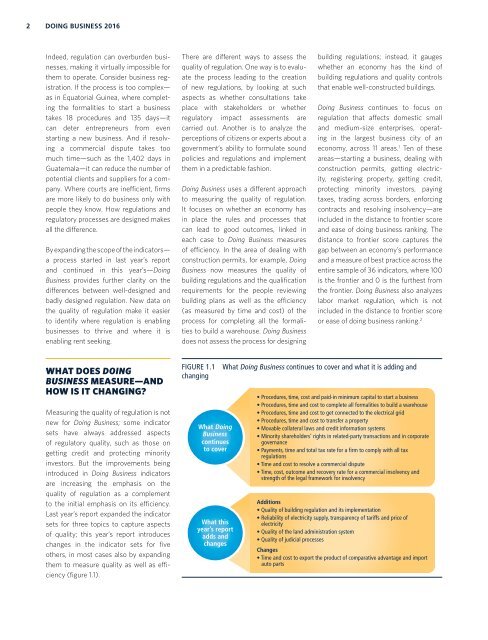Doing Business 2016
1LWKJHK
1LWKJHK
Create successful ePaper yourself
Turn your PDF publications into a flip-book with our unique Google optimized e-Paper software.
2<br />
<strong>Doing</strong> <strong>Business</strong> <strong>2016</strong><br />
Indeed, regulation can overburden businesses,<br />
making it virtually impossible for<br />
them to operate. Consider business registration.<br />
If the process is too complex—<br />
as in Equatorial Guinea, where completing<br />
the formalities to start a business<br />
takes 18 procedures and 135 days—it<br />
can deter entrepreneurs from even<br />
starting a new business. And if resolving<br />
a commercial dispute takes too<br />
much time—such as the 1,402 days in<br />
Guatemala—it can reduce the number of<br />
potential clients and suppliers for a company.<br />
Where courts are inefficient, firms<br />
are more likely to do business only with<br />
people they know. How regulations and<br />
regulatory processes are designed makes<br />
all the difference.<br />
By expanding the scope of the indicators—<br />
a process started in last year’s report<br />
and continued in this year’s—<strong>Doing</strong><br />
<strong>Business</strong> provides further clarity on the<br />
differences between well-designed and<br />
badly designed regulation. New data on<br />
the quality of regulation make it easier<br />
to identify where regulation is enabling<br />
businesses to thrive and where it is<br />
enabling rent seeking.<br />
There are different ways to assess the<br />
quality of regulation. One way is to evaluate<br />
the process leading to the creation<br />
of new regulations, by looking at such<br />
aspects as whether consultations take<br />
place with stakeholders or whether<br />
regulatory impact assessments are<br />
carried out. Another is to analyze the<br />
perceptions of citizens or experts about a<br />
government’s ability to formulate sound<br />
policies and regulations and implement<br />
them in a predictable fashion.<br />
<strong>Doing</strong> <strong>Business</strong> uses a different approach<br />
to measuring the quality of regulation.<br />
It focuses on whether an economy has<br />
in place the rules and processes that<br />
can lead to good outcomes, linked in<br />
each case to <strong>Doing</strong> <strong>Business</strong> measures<br />
of efficiency. In the area of dealing with<br />
construction permits, for example, <strong>Doing</strong><br />
<strong>Business</strong> now measures the quality of<br />
building regulations and the qualification<br />
requirements for the people reviewing<br />
building plans as well as the efficiency<br />
(as measured by time and cost) of the<br />
process for completing all the formalities<br />
to build a warehouse. <strong>Doing</strong> <strong>Business</strong><br />
does not assess the process for designing<br />
building regulations; instead, it gauges<br />
whether an economy has the kind of<br />
building regulations and quality controls<br />
that enable well-constructed buildings.<br />
<strong>Doing</strong> <strong>Business</strong> continues to focus on<br />
regulation that affects domestic small<br />
and medium-size enterprises, operating<br />
in the largest business city of an<br />
economy, across 11 areas. 1 Ten of these<br />
areas—starting a business, dealing with<br />
construction permits, getting electricity,<br />
registering property, getting credit,<br />
protecting minority investors, paying<br />
taxes, trading across borders, enforcing<br />
contracts and resolving insolvency—are<br />
included in the distance to frontier score<br />
and ease of doing business ranking. The<br />
distance to frontier score captures the<br />
gap between an economy’s performance<br />
and a measure of best practice across the<br />
entire sample of 36 indicators, where 100<br />
is the frontier and 0 is the furthest from<br />
the frontier. <strong>Doing</strong> <strong>Business</strong> also analyzes<br />
labor market regulation, which is not<br />
included in the distance to frontier score<br />
or ease of doing business ranking. 2<br />
WHAT DOES DOING<br />
BUSINESS MEASURE—AND<br />
HOW IS IT CHANGING?<br />
Measuring the quality of regulation is not<br />
new for <strong>Doing</strong> <strong>Business</strong>; some indicator<br />
sets have always addressed aspects<br />
of regulatory quality, such as those on<br />
getting credit and protecting minority<br />
investors. But the improvements being<br />
introduced in <strong>Doing</strong> <strong>Business</strong> indicators<br />
are increasing the emphasis on the<br />
quality of regulation as a complement<br />
to the initial emphasis on its efficiency.<br />
Last year’s report expanded the indicator<br />
sets for three topics to capture aspects<br />
of quality; this year’s report introduces<br />
changes in the indicator sets for five<br />
others, in most cases also by expanding<br />
them to measure quality as well as efficiency<br />
(figure 1.1).<br />
FIGURE 1.1 What <strong>Doing</strong> <strong>Business</strong> continues to cover and what it is adding and<br />
changing<br />
What <strong>Doing</strong><br />
<strong>Business</strong><br />
continues<br />
to cover<br />
What this<br />
year’s report<br />
adds and<br />
changes<br />
• Procedures, time, cost and paid-in minimum capital to start a business<br />
• Procedures, time and cost to complete all formalities to build a warehouse<br />
• Procedures, time and cost to get connected to the electrical grid<br />
• Procedures, time and cost to transfer a property<br />
• Movable collateral laws and credit information systems<br />
• Minority shareholders’ rights in related-party transactions and in corporate<br />
governance<br />
• Payments, time and total tax rate for a firm to comply with all tax<br />
regulations<br />
• Time and cost to resolve a commercial dispute<br />
• Time, cost, outcome and recovery rate for a commercial insolvency and<br />
strength of the legal framework for insolvency<br />
Additions<br />
• Quality of building regulation and its implementation<br />
• Reliability of electricity supply, transparency of tariffs and price of<br />
electricity<br />
• Quality of the land administration system<br />
• Quality of judicial processes<br />
Changes<br />
• Time and cost to export the product of comparative advantage and import<br />
auto parts


